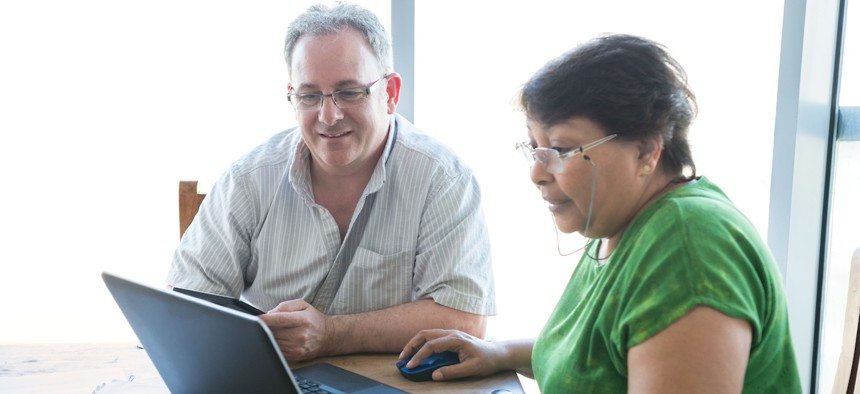How one Ohio county uses tech to help residents navigate the benefits cliff

PamelaJoeMcFarlane via Getty Images
In Summit County, a centralized platform is helping social service workers better support people as they transition out of public assistance programs like Medicaid.
In northeast Ohio, Summit County has turned to a software solution to help ease the transition for people who become ineligible for public benefits programs.
The county — about 34 miles south of the city Cleveland — is the fourth largest metro area in the state, with a population of nearly 540,000 people. In 2022, 76,084 people were enrolled in the Supplemental Nutrition Assistance Program and about 108,500 people were enrolled in Medicaid.
The same year, the county’s Department of Jobs and Family Services launched the NEXT program, which aims to help people navigate a loss or reduction in public benefits as they earn more income — a situation known as a benefits cliff. Under the program, the department partners with other agencies and nonprofits to support participants with job coaching, financial planning, rental assistance and other services to build their self-sufficiency. People can also receive financial incentives for their sustained progress through NEXT.
Getting various organizations to manage individual cases was often “labor intensive” and “had no flow to it,” said Heather Yannayon, deputy director at the Summit County Department of Job and Family Services. “There [were] a lot of phone calls, faxes, spreadsheets and lost connections.”
Enrolling someone into NEXT and its services, for instance, could take weeks to confirm, as staff across the organizations had to coordinate case management through separate systems, she explained. That model limited its staff’s ability to track and monitor cases effectively, leading to time and cost inefficiencies and delaying assistance to participants.
To improve the referral process for staff and service delivery to NEXT participants, DJFS partnered with technology provider Unite Us to leverage its software platform for integrating community-based services. In August 2023, the county implemented the solution that offers a streamlined, centralized system for client data sharing, payment distributions and closed-loop referrals as people move through the program.
Since adopting the platform, NEXT workers have reduced the time spent on administrative tasks by 591 hours, and 88% of end users reported seeing operational efficiency gains with the platform because it helped streamline workflows and communication across organizations.
Yannayon underscored the reduction in stress and burnout among staff that the platform has contributed to, which is a crucial benefit, as social service agencies often grapple with workforce shortages and high workloads.
“We're seeing that our case managers that are dealing with these people's incentives, supportive services and money, their stress level is down because … they can see that the client is getting what they need, and they know that [the platform] is just making their job easier,” she explained.
With the platform, a staff member in DJFS can, for instance, immediately send a referral request to a nonprofit employee to engage with a program participant, and the system shows when the case is picked up by that individual, Yannayon said. Platform users can also share case notes with each other that are updated in real-time to support seamless case monitoring.
“We’re able to monitor our providers and our taxpayer money better, because we’re able to see who is being touched, how long they’re being touched and [make] sure that everybody that we think that they should be serving is getting served,” she said.
The technology is projected to save taxpayers an estimated $9.2 million over the next three years and $21 million over the next decade, said Taylor Justice, co-founder and president of Unite Us. The people served by NEXT are also expected to generate $6.8 million in tax revenue as they earn higher wages and participate more in society.
The platform “works both in a customer-service way, delivering a product in a better way, but it also helps us with efficiency, monitoring and accountability,” Yannayon said.
She pointed to how the Unite Us platform has also helped improve the payment distribution process. A NEXT participant who, for instance, pays down a debt or attends a financial literacy class can earn a monetary incentive for their effort.
Before implementing the platform, staff had to manually track someone’s progress in a spreadsheet, which was error prone and “took a lot of man hours,” Yannayon explained. Now, the platform offers accurate and secure documentation to reduce the time it takes for staff to record someone’s achievement and process their payment.
Data insights from the platform help inform program leaders on how they can improve staff interactions with clients or how services are meeting participants’ needs to “take guess work out of social work,” she said. The program, for instance, adjusted how it was administering a peer-mentoring service because data showed that the original group-setting approach yielded low engagement, based on case note data.
Ultimately, the platform enables agency and nonprofit staff to work more closely with clients to “see what’s going on and intervene quickly … to provide better service to the community,” Yannayon explained, which helps build trust in the county’s social services, “because clients actually start believing that you are going to help them.”






